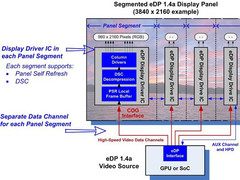While Full HD (1920x1080 pixels), QHD (2560x1440) and Ultra HD 4K (3840x2160) resolutions are able to provide a sufficiently high (and sometimes, even excessive) pixel density on any laptop screen, higher resolutions are required to maintain the same values with larger diagonals. That's why Apple and Dell both introduced "5K" (5120x2880) 27-inch screens (in Apple's case it's a part of the new iMac), both amounting to ~220 ppi. That's almost the same as the 13-inch MacBook Pro Retina (2560x1600, ~230 ppi), and in general is considered high enough to provide a sharp image where separate pixels can't be distinguished at a normal working distance. However, to produce the same pixel density on a 40-inch screen, Ultra HD 8K (7680x4320) resolution is required. This is why VESA (Video Electronics Standards Association) has now updated the Embedded DisplayPort (eDP) standard to version 1.4a, adding support for this resolution.
Compared to eDP 1.4 (which was introduced in February 2013) the updated eDP 1.4a increases video data transfer rate and adds better compression. Additionally, a new technology called "Multi-SST operations" (MSO) was introduced. It allows to separate the display panel into several smaller segments (e.g. in case of 4K, four 960x2160 stripes) each connected via its own data channel and thus able to be controlled independently, leading to increased energy efficiency.
Embedded DisplayPort is used in most modern laptops as a means to connect the internal screen to the graphics card, but even Ultra HD 4K on a 17.3-inch display provides a high ~254 ppi, making a need for 8K resolution in laptops very questionable. But eDP is also used in all-in-one (AIO) computers, which nowadays get as large as 27 inch and could theoretically grow even bigger in the future, requiring higher resolutions such as 8K for maintaining a high pixel density. Either way, a considerable increase in graphics performance will be required to drive such panels, especially if games are to be considered. But VESA claims that the first products with eDP 1.4a will appear on the market already next year - we're eager to see what they will be.




